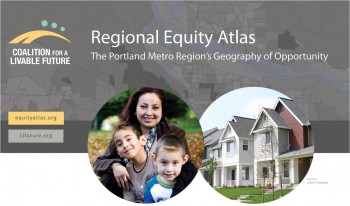This toolkit is intended to support communities in creating equity atlas projects by providing an overview of the equity atlas development process along with sample materials and links to helpful resources.
An equity atlas is a tool that enables us to understand how well different neighborhoods and populations are able to access the resources and opportunities necessary for meeting their basic needs and advancing their health and well-being. By providing a visual depiction of disparities, equity atlases can play a powerful role in guiding policy, planning, and strategic investments to create more equitable communities.
 The Coalition for a Livable Future (CLF) launched the nation’s first equity atlas in 2007, transforming the policy landscape in the Portland, Ore., metro region. CLF’s Regional Equity Atlas reframed local decision-making to focus more explicitly on equity issues and produced concrete changes in regional planning strategies and investment priorities.
The Coalition for a Livable Future (CLF) launched the nation’s first equity atlas in 2007, transforming the policy landscape in the Portland, Ore., metro region. CLF’s Regional Equity Atlas reframed local decision-making to focus more explicitly on equity issues and produced concrete changes in regional planning strategies and investment priorities.
The original Regional Equity Atlas was published as a book of maps and analysis. Advances in mapping technology since then have vastly expanded the potential for using maps to inform decision-making. In 2013, CLF released an updated version called the Regional Equity Atlas 2.0, which includes an online mapping tool that gives users the ability to create their own maps; an interpretive website with background information and analysis; and a host of complementary features such as a storytelling project and a white paper series.
Other regions around the country have been inspired by the Regional Equity Atlas to initiate similar projects in their own communities. Building on CLF’s example, three regions have completed their own equity atlases (Denver, Los Angeles, and Atlanta), and many others have expressed interest in launching equity atlas projects.

